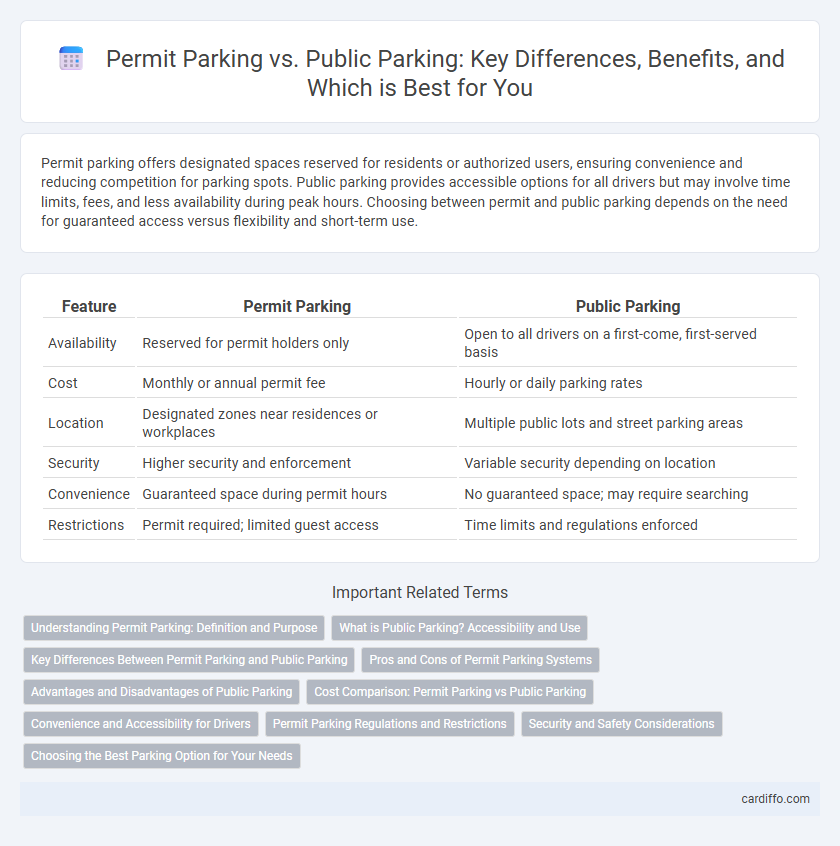Permit parking offers designated spaces reserved for residents or authorized users, ensuring convenience and reducing competition for parking spots. Public parking provides accessible options for all drivers but may involve time limits, fees, and less availability during peak hours. Choosing between permit and public parking depends on the need for guaranteed access versus flexibility and short-term use.
Table of Comparison
| Feature | Permit Parking | Public Parking |
|---|---|---|
| Availability | Reserved for permit holders only | Open to all drivers on a first-come, first-served basis |
| Cost | Monthly or annual permit fee | Hourly or daily parking rates |
| Location | Designated zones near residences or workplaces | Multiple public lots and street parking areas |
| Security | Higher security and enforcement | Variable security depending on location |
| Convenience | Guaranteed space during permit hours | No guaranteed space; may require searching |
| Restrictions | Permit required; limited guest access | Time limits and regulations enforced |
Understanding Permit Parking: Definition and Purpose
Permit parking is a designated parking system requiring drivers to obtain a valid permit for authorized areas, ensuring prioritized access and regulated use. It helps manage limited parking resources, reduces congestion, and provides convenience for residents or specific groups. Permit parking zones often involve fees or restrictions that support local traffic control and environmental goals.
What is Public Parking? Accessibility and Use
Public parking refers to parking spaces available for use by the general public, typically managed by municipal authorities or private entities. These areas are designed for easy accessibility, often located near commercial centers, transit hubs, and popular destinations, providing convenience for short-term parking needs. Public parking is generally metered or free, with varying regulations to accommodate different durations and vehicle types.
Key Differences Between Permit Parking and Public Parking
Permit parking requires a valid permit issued by local authorities or institutions, restricting access to authorized vehicles only, whereas public parking is open to all drivers regardless of permits. Permit parking often involves designated zones with limited availability to prioritize residents or employees, while public parking spaces are generally available on a first-come, first-served basis. Pricing structures differ as permit parking typically involves a fixed fee or subscription, contrasted with public parking's hourly or daily rates.
Pros and Cons of Permit Parking Systems
Permit parking systems offer designated spaces reserved for residents or authorized users, reducing congestion and enhancing neighborhood safety. However, these systems can create barriers for visitors and generate administrative costs related to permit issuance and enforcement. Public parking provides flexible access but often leads to overcrowding and limited availability in high-demand areas.
Advantages and Disadvantages of Public Parking
Public parking offers convenient access for short-term visitors without the need for permits, making it ideal for spontaneous trips and tourist areas. However, it often comes with higher costs and limited availability during peak times, leading to potential difficulty finding spaces. The lack of reserved spots can result in increased traffic congestion and reduced predictability for users compared to permit parking systems.
Cost Comparison: Permit Parking vs Public Parking
Permit parking often provides a cost-effective solution for long-term parking needs, typically charging a fixed monthly or annual fee that can be lower than daily public parking rates. Public parking spaces usually require payment per hour or day, which can accumulate to a higher expense for frequent users compared to permit parking. Evaluating the total parking costs based on usage frequency and duration reveals that permit parking offers substantial savings for regular parkers in urban areas.
Convenience and Accessibility for Drivers
Permit parking offers designated spaces reserved for permit holders, ensuring guaranteed parking availability and reducing the time drivers spend searching for spots. Public parking provides more flexible access without restrictions, but often results in longer wait times and increased competition, especially in high-demand areas. Drivers prioritizing convenience and guaranteed accessibility typically prefer permit parking, while those valuing flexibility may opt for public parking despite potential challenges.
Permit Parking Regulations and Restrictions
Permit parking regulations restrict vehicle access to designated areas, requiring drivers to obtain a valid permit from local authorities to park legally. These permits often limit parking duration, vehicle type, and eligibility based on residency or business affiliation, ensuring controlled use of limited parking spaces. Violations of permit parking rules typically result in fines, towing, or penalties, emphasizing the importance of compliance with municipality-specific regulations.
Security and Safety Considerations
Permit parking offers enhanced security through controlled access and designated spaces, reducing risks of theft and vandalism. Public parking areas often lack stringent monitoring, making vehicles more vulnerable to break-ins and damage. Implementing surveillance cameras and regular patrols can significantly improve safety in both permit and public parking zones.
Choosing the Best Parking Option for Your Needs
Permit parking offers reserved spaces ideal for residents or employees who require guaranteed access, reducing daily search time and enhancing convenience. Public parking provides flexible, pay-as-you-go options suitable for short-term visitors or those needing sporadic access in busy urban areas. Choosing the best parking option depends on factors like frequency of use, budget, and proximity to destination to maximize efficiency and cost-effectiveness.
Permit Parking vs Public Parking Infographic

 cardiffo.com
cardiffo.com